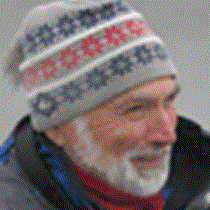Tracy Arm
Many people consider Tracy Arm to be the most beautiful fiord in the world. It has it all, massive towering cliffs that rise over 3,000 feet, rocks that jut straight up out of the water, snow-capped peaks, and high green hillsides that mix with clouds and mountain goats. Waterfalls seem to fill every gully. They descend step after step then freefall into space, break into a thousand droplets and recollect into another cascade. The walls are close, the passage seems intimate, the feelings it conjures up are powerful, and the scenery creeps into you. You find yourself yearning to explore every hanging valley.
We entered into this magical place just after breakfast. The overcast skies were clearing as we approached “Hole in the Wall” waterfall. Captain Graves deftly pulled the ship in almost close enough to touch the water that careened out of a hollow and fell downward. Soon we approached another waterfall named “Ice Falls” and again pocked in close to cascading water.
The geology of Tracy Arm fiord is notable. Magma fed by the subduction of an offshore plate welled up within six miles of the surface some 80 to 120 million years ago forming granite and tonalite. Sediments eroding from the western edge of North America were deposited against the margin but were later smashed against the continent by the arrival of an exotic terrane. The pressure from the docking and the heat from magma gave us the gneiss, schist, and other metamorphic rocks that surround us. These and the granites are what Sawyer Glacier carved through to give us the scenery we admire.
Today’s photograph is a special one for Lindblad Expeditions. We’ve never kayaked in Tracy Arm before. We aren’t new to these activities by any means, but kayaking in an 800-foot-deep fiord without adequate beaches to launch kayaks offers its own challenges. Kayaking in the Antarctic and around pack ice in the Arctic has given us the experience necessary to be able to pull this off. What a treat it was! The photograph shows the junction where Sawyer and South Sawyer Glaciers met in the 1800’s. Both have calved a large amount of ice this year, which offers the activity of sculpture naming by our boaters. Zodiac tours were also a special part of this day.
A week has passed. Our trip is almost at an end. The memories will live on and may return while we wait at a traffic light or sip our morning coffee. Southeast Alaska is a most magnificent place.
Many people consider Tracy Arm to be the most beautiful fiord in the world. It has it all, massive towering cliffs that rise over 3,000 feet, rocks that jut straight up out of the water, snow-capped peaks, and high green hillsides that mix with clouds and mountain goats. Waterfalls seem to fill every gully. They descend step after step then freefall into space, break into a thousand droplets and recollect into another cascade. The walls are close, the passage seems intimate, the feelings it conjures up are powerful, and the scenery creeps into you. You find yourself yearning to explore every hanging valley.
We entered into this magical place just after breakfast. The overcast skies were clearing as we approached “Hole in the Wall” waterfall. Captain Graves deftly pulled the ship in almost close enough to touch the water that careened out of a hollow and fell downward. Soon we approached another waterfall named “Ice Falls” and again pocked in close to cascading water.
The geology of Tracy Arm fiord is notable. Magma fed by the subduction of an offshore plate welled up within six miles of the surface some 80 to 120 million years ago forming granite and tonalite. Sediments eroding from the western edge of North America were deposited against the margin but were later smashed against the continent by the arrival of an exotic terrane. The pressure from the docking and the heat from magma gave us the gneiss, schist, and other metamorphic rocks that surround us. These and the granites are what Sawyer Glacier carved through to give us the scenery we admire.
Today’s photograph is a special one for Lindblad Expeditions. We’ve never kayaked in Tracy Arm before. We aren’t new to these activities by any means, but kayaking in an 800-foot-deep fiord without adequate beaches to launch kayaks offers its own challenges. Kayaking in the Antarctic and around pack ice in the Arctic has given us the experience necessary to be able to pull this off. What a treat it was! The photograph shows the junction where Sawyer and South Sawyer Glaciers met in the 1800’s. Both have calved a large amount of ice this year, which offers the activity of sculpture naming by our boaters. Zodiac tours were also a special part of this day.
A week has passed. Our trip is almost at an end. The memories will live on and may return while we wait at a traffic light or sip our morning coffee. Southeast Alaska is a most magnificent place.




